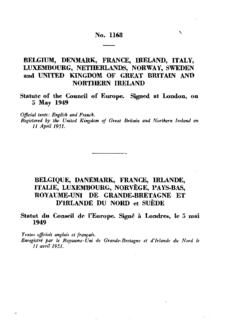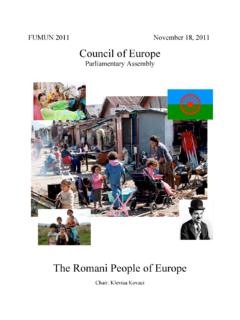Transcription of Commodity Markets Council - Europe
1 1 Commodity Markets Council - Europe Hume Brophy 41 Rue de la Science 1040 Brussels Belgium Secretariat Tel: +32 (0)2 234 6860 Fax: +32 (0)2 649 2593 Eml: Wb: www. MiFID II & MiFIR: Applying the Definition of Spot to Physical Commodities Contracts On 3rd January 2018, MiFID II and MiFIR will become applicable1. Physically-settled commodities contracts may be financial instruments for the purposes of MiFID II, if they fall within the categories set out at paragraphs 6 or 7 of Section C of Annex I to MiFID II ( C6 and C7 ). It is critical for Commodity market participants to be able to distinguish between physically-settled Commodity contracts which are financial instrument and those which are not. This distinction affects (for example): the application of EMIR to these contracts; the treatment of these contracts under netting legislation in certain Member States; the application of position limits and position reporting obligations under MiFID II in respect of these contracts and the calculation of positions for those purposes; the regulatory implications of using or providing brokerage services in these contracts; and for investment firms which will be authorised under MiFID II, the scope of transaction reporting and other obligations under MiFID II.
2 For many market participants it is also vital to determine reliably what is and what is not a financial instrument under C6 and C7, because this is a pre-requisite for calculating the thresholds determining the applicability of the ancillary business exemption under article 2(1)(j) of MiFID II. These include thresholds calculated by reference to the gross notional value of activities in Commodity derivatives and thresholds based on the amount of capital employed in respect of activity in Commodity derivatives 2. Commodity derivatives for these purposes include physical Commodity contracts which are financial instruments under C6 and 1 Directive 2014/65/EU and Regulation (EU) 600/2014. Member States are required to transpose MiFID II by 3 July 2017 in national laws, rules and regulations which must become applicable on 3 January 2018.
3 MiFIR becomes applicable in the laws of Member States automatically on that date. 2 These thresholds are set out in Commission Delegated Regulation (EU)2017/592 (published on 31 March 2017) with regard to regulatory technical standards for the criteria to establish when an activity is considered to be ancillary to the main business [Link]. 3 Commodity derivatives are defined at article 2(1)(30) of MiFIR. 2 This paper, therefore, considers the application of one aspect of the definition of C7 financial instruments : the definition of spot . 1. Physically-settled Commodity contracts and the C7 financial instrument definition C7 financial instruments are defined as: (7) Options, futures, swaps, forwards and any other derivative contracts relating to commodities, that can be physically settled not otherwise mentioned in point 6 of this Section and not being for commercial purposes, which have the characteristics of other derivative financial instruments; A physically-settled Commodity contract is a C7 financial instrument if (a) it not already caught as a C6 financial instrument, (b) it is not.
4 For commercial purposes and (c) it has the characteristics of other derivative financial instruments . Article 7 of the Level 2 Delegated Regulation4 defines whether a physical Commodity contract is not for commercial purposes and has the characteristics of other derivative financial instruments for these purposes. Article 7(1) provides that a contract which is not a spot contract in accordance with [article 7(2)] and which is not for commercial purposes has the characteristics of other derivative financial instruments where specified conditions are met. A spot contract as defined under article 7(2) of the Level 2 Delegated Regulation, therefore is not a C(7) financial instrument. Article 7(2) provides: A spot contract for the purposes of [article 7(1)] shall be a contract for the sale of a Commodity , asset or right, under the terms of which delivery is scheduled to be made within the longer of the following periods: (a) 2 trading days; (b) the period generally accepted in the market for that Commodity , asset or right as the standard delivery period.
5 2. Applying the Definition of Spot Contract to Specific Classes of Contract Contracts scheduled for delivery with a period longer than 2 trading days are, therefore, spot contracts where the delivery period is within the period generally accepted in the market for that Commodity . The classification of these contracts therefore turns on a question of fact: for each Commodity , what is the period generally accepted in the market? CMCE and its members have considered how best to determine the answer to this question. What is the best evidence available from which to assess what period is generally accepted in the market for any given Commodity ? 4 Commission Delegated Regulation (EU)2017/592 as regards organisational requirements and operating conditions for investment firms and defined terms [Link].
6 3 This is not a matter on which any guidance is expected from the European Securities Market Authority or any national competent authority. CMCE s members comprise a substantial and representative portion of the market participants in several Commodity classes. CMCE and its members have concluded that where a Price Reporting Agency publishes a price or index as the spot price or index for a particular Commodity (and where that price or index is in general use by the market), that will invariably represent the best available evidence of the period generally accepted by the market for that Commodity . PRAs establish methodologies for their price assessment for physical commodities by reference to the key features and practices of the Markets for those commodities, including in the case of spot prices making an assessment of the period generally treated as spot by the market.
7 PRAs may assess prices for several time periods and may not explicitly define any of these periods as spot . In addition, PRAs may refer to several time periods as spot for the same Commodity in the same market. CMCE members therefore consider that, when seeking to apply the definition of spot contract in Article 7(2) of Commission Delegated Regulation (EU)2017/592, the best indication of the spot period - for the commodities set out in the Annex to this paper - is the period specified as spot in the methodologies of the PRAs whose spot prices are in general use in the market. Depending on the delivery mechanisms and delivery points for a given Commodity , the spot period can vary considerably and that is reflected in the PRAs methodologies for the spot prices set out in the Annex to this paper.
8 Not Legal Advice or Guidance This paper should not be treated as providing legal advice or guidance on the interpretation of MiFID II or MiFIR and should not be relied on as such by any person. CMCE and its members have engaged in an exercise to determine matters of fact on the best evidence available to them. CMCE s conclusions should not be regarded as providing certainty on the application of the definition of spot contract . It is the responsibility of each market participant to apply the definition based on the latest data included in the PRAs methodologies. CMCE acknowledges that the classification established by the PRAs is dynamic and may evolve over time to reflect the evolving structure of Commodity Markets . PRAs adjust their methodologies to reflect market practices and cannot be responsible for any adverse consequence in the classification of a contract for the purposes of C7 resulting from a change in any of the spot price methodologies.
9 About the Commodities Markets Council Europe CMCE is an industry group bringing together commercial market participants active across agriculture and soft Commodity , energy, base and precious metals and environmental Markets . The group includes Commodity producers, merchandisers and consumers, Commodity trading venues and price reporting agencies. CMCE advocates effective regulation that facilitates the key role of these Markets in price discovery and risk management. For more information, see 4 ANNEX Illustrative examples of time periods considered spot based on Price methodologies for oil5 Summary level: Crude West Africa Crude 60 days North Sea Crude 30 days Urals and Med Crude 45 days Persian Gulf Crude 120 days Asia Pacific Crude 75 days WTI 60 days Canada 45 days Latin America 60 days Oil Products Cargos Jet 40 days Diesel 25 days Gasoline 30 days Naphtha 75 days Heating Oil 25 days LPG 45 days Fuel Oil 40 days Barges Jet 15 days Diesel 15 days Gasoline 15 days Naphtha 30 days Fuel Oil 15 days Heating Oil 15 days LPG 15 days Biofuels 60 days Marine Fuels 8 days Eurobob 10 days Pumpover 15 days Tank 15 days Train 15 days Sources: Argus methodology and reference.
10 Platts methodology and specifications: 5 It should be noted that the table is illustrative only. It is the responsibility of each market participant to apply the definition of spot based on the latest data included in the PRAs methodologies.









